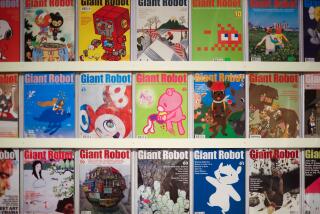Review: Takashi Murakami captivates at Blum & Poe
Back in the 1960s, Marshall McLuhan predicted that modern technology would turn the world into a global village. Now that that’s come to pass, the most captivating art being made today begins with a savvy understanding of its conflicted place in a world where the reality of instantaneous communication has replaced the fantasy of instantaneous gratification.
Takashi Murakami does that and more. A whole lot more.
In a mind-blowing, eye-opening, soul-searching exhibition at Blum & Poe, the 51-year-old Japanese artist makes globalism look provincial — not quite quaint, but too limited a way of thinking about the big picture. Rather than asking visitors to see themselves as inhabiting a global village, Murakami invites us to enter a cosmic metropolis.
FULL COVERAGE: 2013 Spring arts preview
Earthly existence does not disappear so much as it gets integrated into a sublime vision of infinity. Past and future swirl around each other, forming a hallucinatory stew of being and nothingness.
Suffering and insight go hand in glove as humility and serenity show themselves to be more potent than the flashy theatrics that fuel the kind of mindless consumerism with which Murakami’s earlier works often flirted.
That’s not to say that Murakami’s four-gallery extravaganza abandons spectacle for down-to-earth simplicity. Any one of the four works in the first gallery packs enough punch to stop you dead in your tracks. Nearly 10 feet tall and more than 32 feet long, the two largest paintings are jam-packed with so much to see that it’s easy to get lost in their visual density.
Labyrinthine patterns, made of gold and platinum leaf, form dazzling backdrops that, on their own, put Op art to shame. The robes that clothe the legions of figures come in all colors and present an encyclopedic survey of the various ways paint can be applied: swiftly and slowly, by hand and screen-print, abstractly and representationally.
PHOTOS: Arts and culture in pictures by The Times
Murakami’s figures also come in all sizes, from gremlin-scale minis to larger-than life-size monsters. All look as contemporary as comic books and as ancient as arhats, the deathless beings (that predate Buddhism) they represent. Every style under the sun can be found in these paintings, which seem to be on equal terms with the intimacy of Persian miniatures and public nature of murals by Orozco, Rivera and Siqueiros.
A shiny gold sculpture, of sinuous flames spiraling around a stylized skull, provides a jolt of transcendence amid the paintings’ inclusive individualism. Like a Baroque altarpiece from the future, a hood ornament from a low-rider spaceship, or a super-sized fragment from a Buddhist shrine, Murakami’s glistening masterpiece brings so many ideas to mind that you have no choice but to think for yourself.
That holds true in the remaining three galleries, where Murakami sets the stage for complex meditations on the meaning of mortality. Humor and silliness play their part in the artist’s increasingly mature works, which, in making a place for pathos, empathy and wisdom, distinguish themselves from just about everything out there.
Blum & Poe, 2727 S. La Cienega Blvd., (310) 836-2062, through May 25. Closed Sundays and Mondays. www.blumandpoe.com
MORE
INTERACTIVE: Christopher Hawthorne’s On the Boulevards
CHEAT SHEET: Spring Arts Preview
PHOTOS: Arts and culture in pictures
More to Read
The biggest entertainment stories
Get our big stories about Hollywood, film, television, music, arts, culture and more right in your inbox as soon as they publish.
You may occasionally receive promotional content from the Los Angeles Times.










